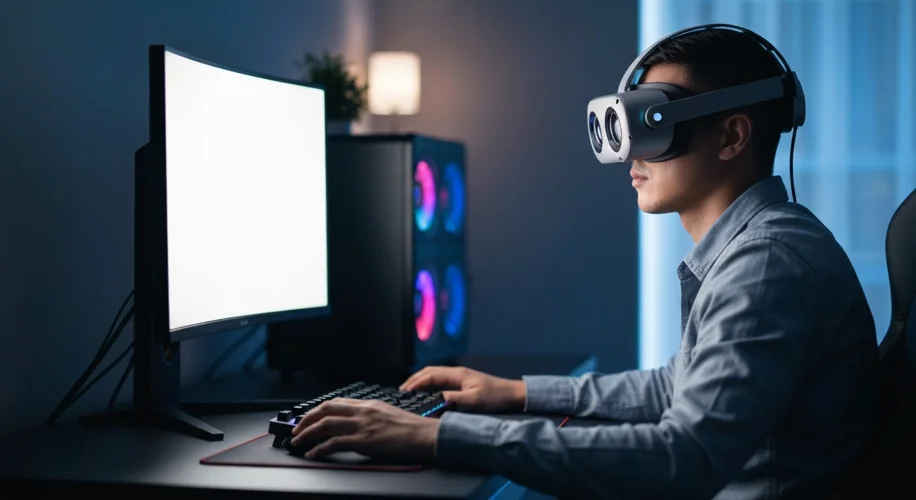So, you’re looking to dive into the world of PC Virtual Reality but don’t know where to start? That’s awesome! PC VR can be an incredible experience, especially for gaming, and choosing the right headset is key. Let’s break down what you should consider, especially with your PC specs, budget, and your interest in things like sim racing and those sweet pancake lenses.
First Things First: Your PC Specs Matter
Before you even think about buying a headset, you need to know if your PC can actually handle it. PC VR is demanding! Check the recommended specs for the headsets you’re eyeing. Generally, you’ll want a pretty beefy graphics card (GPU), a decent processor (CPU), and enough RAM. If you’re into sim racing, those games are notoriously GPU-hungry.
- GPU: Aim for something like an NVIDIA GeForce RTX 3060 Ti / 4060 Ti or an AMD Radeon RX 6700 XT / 7700 XT as a solid starting point. Higher is always better for smoother performance and higher resolutions.
- CPU: A modern mid-range to high-end CPU will do. Think Intel Core i5/i7 (12th gen or newer) or AMD Ryzen 5/7 (5000 series or newer).
- RAM: 16GB is usually the minimum, but 32GB will give you more headroom.
Budget: How Much Are We Talking?
PC VR headsets range quite a bit in price. You’ve got budget options that can get you into the game, mid-range choices that offer a good balance, and high-end systems that push the envelope.
- Entry-Level: You might find headsets in the $300-$500 range that can get you started, but be prepared for potential compromises on display quality or comfort.
- Mid-Range: This is where most people land. Expect to spend between $500 and $800 for solid headsets with good visuals and features. Many of these will connect to your PC via a cable or wirelessly.
- High-End: For the absolute best visual fidelity, comfort, and features like eye-tracking, you could be looking at $1000+.
Key Features to Look For
Pancakes lenses, micro-OLED screens, anti-fogging, and eye tracking – these are all great features, and it’s smart to be aware of them!
- Pancake Lenses: These are a newer type of lens that allow for slimmer, lighter headsets and a wider ‘sweet spot’ for clear vision. They’re becoming more common and are a definite plus.
- Micro-OLED Screens: These offer incredible contrast, vibrant colors, and deep blacks. If you see this, expect a really sharp and immersive visual experience. They’re usually found in higher-end headsets.
- Anti-Fogging: Especially important if you’re going to be moving around or playing intense games. Some headsets have built-in fans or special coatings to combat this.
- Eye Tracking: This allows the headset to know where you’re looking. It’s used for features like foveated rendering (where the system only renders in high detail where you’re looking, saving processing power) and can make social VR interactions more natural.
What About Specific Games and Experiences?
- Sim Racing: For sim racing, clarity and a wide field of view (FOV) are crucial. You want to feel like you’re actually in the cockpit. Headsets with higher resolutions and wider FOV will give you the best immersion. Pancake lenses can really help here with edge-to-edge clarity.
- General PC Gaming: Most PC VR headsets will handle a wide variety of games well. Just make sure your PC can keep up with the demands of the specific titles you want to play.
So, What PC VR Headset Should You Consider?
Given your interest in features like pancake lenses and your desire for PC VR gaming, here are a couple of categories to look into:
- The Wireless All-Rounders: Many newer headsets offer a great wireless PC VR experience, which is super convenient. Look for ones that have good tracking, decent resolution, and yes, those pancake lenses if you can find them in your budget.
- The High-Fidelity Wired Options: If you want the absolute best visuals and don’t mind a cable, there are premium headsets that focus on high resolution, advanced optics, and features like eye tracking. These will often demand more from your PC.
Do a little research on current models available as of late 2025. Read reviews, watch video comparisons, and see what fits your budget and your PC’s capabilities. The VR landscape changes fast, but focusing on these core aspects will help you make a solid choice for your first PC VR adventure!

